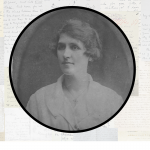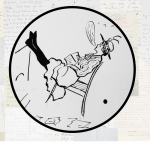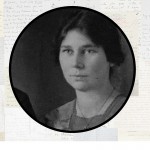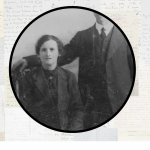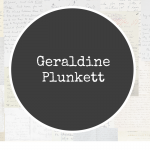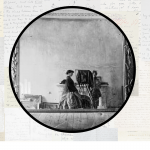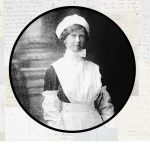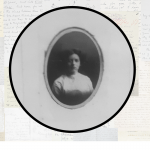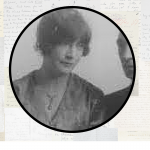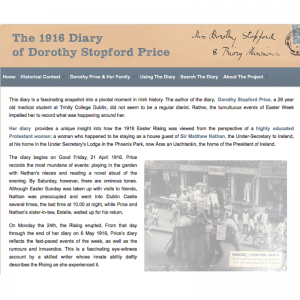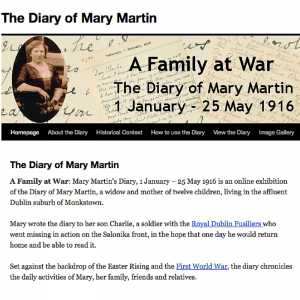8th March is International Women’s Day and people around the world are uniting to help forge a better working world – a more gender inclusive world. To mark the day, we would like to highlight some of the women from the Letters of 1916 collection.
Click on a slide to view the letter:
-
 Letter from Helen Duffin to Celia Duffin 22 December 1915Helen and Celia Duffin are two of Adam and Maria Duffin's nine children. At the age of sixteen, all seven Duffin girls attended Cheltenham Ladies College in Gloucestershire, England. Celia Duffin along with her sister Ruth published a book of poems titled "Escape Poem" (illustrated by their sister Emma Duffin) and published by Maunsell & Co. Ltd in 1913.
Letter from Helen Duffin to Celia Duffin 22 December 1915Helen and Celia Duffin are two of Adam and Maria Duffin's nine children. At the age of sixteen, all seven Duffin girls attended Cheltenham Ladies College in Gloucestershire, England. Celia Duffin along with her sister Ruth published a book of poems titled "Escape Poem" (illustrated by their sister Emma Duffin) and published by Maunsell & Co. Ltd in 1913. -
 A letter to Bride Morris from her friend Margaret Bourke Sheridan , 29 July 1916Bride Morris had a dairy and provisions shop at No.4 Moore Street in Dublin which was destroyed during the Rising. By the morning of 29 April the dairy was ablaze and Bride and a group of neighbours attempted to cross the street to escape the fire. Despite the white flags she and others carried, the British army opened fire, killing Mr Dillon of No.8 Moore St. Showing tremendous courage, Bride later went alone to the British army barricade to appeal to the officer in charge to allow the civilian group to leave Moore St. She subsequently went back down Moore St with the dead man's daughter to retrieve his body, and again the army did not hold their fire.
A letter to Bride Morris from her friend Margaret Bourke Sheridan , 29 July 1916Bride Morris had a dairy and provisions shop at No.4 Moore Street in Dublin which was destroyed during the Rising. By the morning of 29 April the dairy was ablaze and Bride and a group of neighbours attempted to cross the street to escape the fire. Despite the white flags she and others carried, the British army opened fire, killing Mr Dillon of No.8 Moore St. Showing tremendous courage, Bride later went alone to the British army barricade to appeal to the officer in charge to allow the civilian group to leave Moore St. She subsequently went back down Moore St with the dead man's daughter to retrieve his body, and again the army did not hold their fire. -
 Letter from Patrick O'Loughlin to Ellen O'Loughlin, 23 August 1916Ellen O'Loughlin ran a small shop at 39 Lower Kevin Street in Dublin with her husband, Patrick. This letter was written in reply to a letter Patrick had written while on a business trip to Glasgow.
Letter from Patrick O'Loughlin to Ellen O'Loughlin, 23 August 1916Ellen O'Loughlin ran a small shop at 39 Lower Kevin Street in Dublin with her husband, Patrick. This letter was written in reply to a letter Patrick had written while on a business trip to Glasgow. -
 Postcard from Eileen Corrigan to her mother, Mrs Corrigan, 24 April 1916Eileen Corrigan had arrived in Dublin on 24 April 1916, the first day of the Easter Rising, from Belfast to sit her exams in the Trinity College and wrote this note to her mother in order to let her know that communication for Dublin had stopped but that she had arrived safely. Eileen was one of just four female students who sat their exams as rebellion and counter attack swirled about outside Trinity’s walls.
Postcard from Eileen Corrigan to her mother, Mrs Corrigan, 24 April 1916Eileen Corrigan had arrived in Dublin on 24 April 1916, the first day of the Easter Rising, from Belfast to sit her exams in the Trinity College and wrote this note to her mother in order to let her know that communication for Dublin had stopped but that she had arrived safely. Eileen was one of just four female students who sat their exams as rebellion and counter attack swirled about outside Trinity’s walls. -
 Letter from Private Cahill to Lady Clonbrock 19 March 1916Lady Clonbrock was a prominent member of the Irish Women's Association, founded to provide aid and assistance to Irish soldiers and prisoners of war.
Letter from Private Cahill to Lady Clonbrock 19 March 1916Lady Clonbrock was a prominent member of the Irish Women's Association, founded to provide aid and assistance to Irish soldiers and prisoners of war. -
 Letter from George Noble Plunkett to Geraldine Plunkett Dillon 18 May 1916Geraldine was a sister of Joseph Mary Plunkett (1887-1916), one of the signatories of the proclamation of the Irish republic who was executed for his part in the Easter Rising. Geraldine married her fiancé, Tommy Dillon, on Easter Sunday 1916. Tommy, an Irish Volunteer, was ordered to manufacture explosives in the Imperial Hotel opposite the GPO where they spent their wedding night.
Letter from George Noble Plunkett to Geraldine Plunkett Dillon 18 May 1916Geraldine was a sister of Joseph Mary Plunkett (1887-1916), one of the signatories of the proclamation of the Irish republic who was executed for his part in the Easter Rising. Geraldine married her fiancé, Tommy Dillon, on Easter Sunday 1916. Tommy, an Irish Volunteer, was ordered to manufacture explosives in the Imperial Hotel opposite the GPO where they spent their wedding night. -
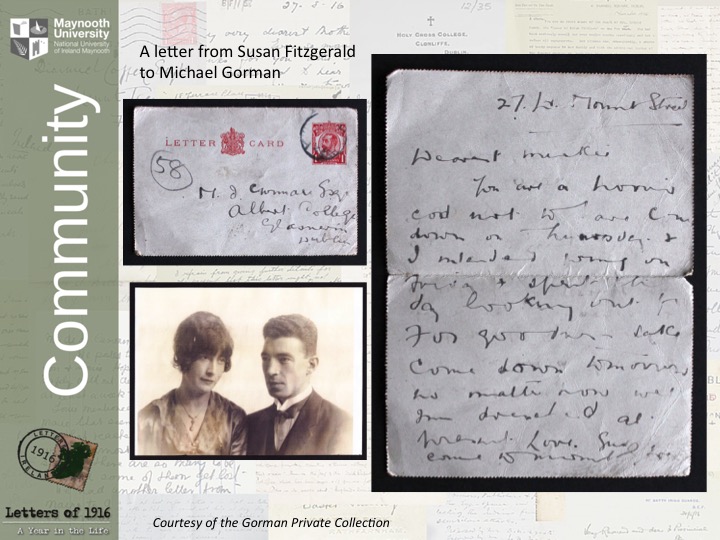 A letter from Susan Fitzgerald to Michael GormanSusan Fitzgerald was one a Church of Ireland family living in Raheenahone House near Stradbally, County Laois. She was involved in a courtship with Michael Gorman, a catholic. Owing to the religious difference the love affair had to be kept secret until they eventually went to London to marry. This letter was written after Susan had arrived in Dublin as part of the Voluntary Aid Detachment, a voluntary group established to provide nursing to wounded British army soldiers. She refers to Michael as a 'horrid cod' for not coming to see her and asks that he visit tomorrow.
A letter from Susan Fitzgerald to Michael GormanSusan Fitzgerald was one a Church of Ireland family living in Raheenahone House near Stradbally, County Laois. She was involved in a courtship with Michael Gorman, a catholic. Owing to the religious difference the love affair had to be kept secret until they eventually went to London to marry. This letter was written after Susan had arrived in Dublin as part of the Voluntary Aid Detachment, a voluntary group established to provide nursing to wounded British army soldiers. She refers to Michael as a 'horrid cod' for not coming to see her and asks that he visit tomorrow. -
 Letter from May Fay to James Finn, 1 June 1916May Fay became engaged to James Finn in January 1916 and married in June. He lived in Dublin, she in Westmeath. He was 20 years older than her at 39 and had become acquainted with her during his regular visits to his relative Mrs Mary Seery, her neighbour. Throughout this series of over 90 letters, their relationship develops from the first somewhat tentative letters.
Letter from May Fay to James Finn, 1 June 1916May Fay became engaged to James Finn in January 1916 and married in June. He lived in Dublin, she in Westmeath. He was 20 years older than her at 39 and had become acquainted with her during his regular visits to his relative Mrs Mary Seery, her neighbour. Throughout this series of over 90 letters, their relationship develops from the first somewhat tentative letters. -
 A postcard from Patrick Pearse to Mary Ita McEvoy, 24 February 1916Mary Ita McEvoy was born in 1890 in Glenquin, Co Clare. She was one of four children, and the only girl. After finishing school in Newcastlewest, she trained as a teacher in Mary Immaculate College (Limerick). While there she met Sinead Flanagan (who later married Eamonn de Valera). Her first teaching job was in a school in Monaleen, outside Limerick, where stayed with her two Aunts who had a Bed and Breakfast in William Street. While there she met 1916 leader Seán Mac Diarmada, and many others involved in the Rising, who stayed at her Aunts' from time to time. Meetings were held and dances were organised to promote the fight for Irish Freedom. Mary attended her first dance with Seán Mac Diarmada.
A postcard from Patrick Pearse to Mary Ita McEvoy, 24 February 1916Mary Ita McEvoy was born in 1890 in Glenquin, Co Clare. She was one of four children, and the only girl. After finishing school in Newcastlewest, she trained as a teacher in Mary Immaculate College (Limerick). While there she met Sinead Flanagan (who later married Eamonn de Valera). Her first teaching job was in a school in Monaleen, outside Limerick, where stayed with her two Aunts who had a Bed and Breakfast in William Street. While there she met 1916 leader Seán Mac Diarmada, and many others involved in the Rising, who stayed at her Aunts' from time to time. Meetings were held and dances were organised to promote the fight for Irish Freedom. Mary attended her first dance with Seán Mac Diarmada. -
 A Postcard from Marie Martin to Miss Martin, 1915Marie Martin was a volunteer nurse during the First World War. She served in field hospitals in Malta, Leeds and France, working for the British army. She later went on to become the founder of the Medical Missionaries of Mary (MMM).
A Postcard from Marie Martin to Miss Martin, 1915Marie Martin was a volunteer nurse during the First World War. She served in field hospitals in Malta, Leeds and France, working for the British army. She later went on to become the founder of the Medical Missionaries of Mary (MMM).
Alternatively, click on a photo in the gallery below to view a related letter:
1916 Diaries – Mary Martin | Dorothy Stopford Price
Prior to working on the Letters of 1916 project, Professor Susan Schreibman worked with her students to create editions of two 1916 diaries written by Mary Martin and Dorothy Stopford-Price. The diaries are searchable for specific people and places, and can be read chronologically, or by a specific entry.
this is a repost of a 2016 post
